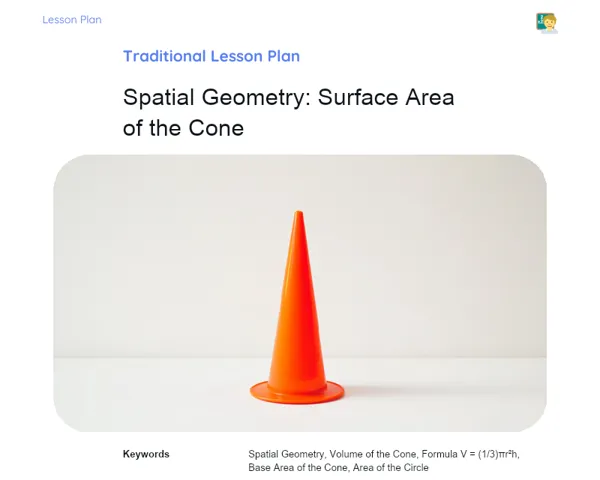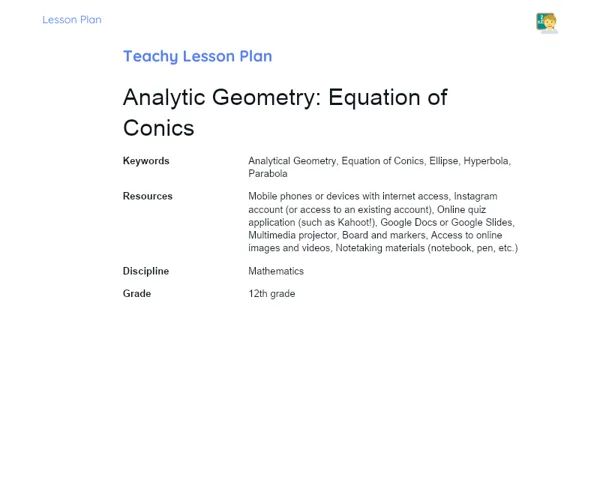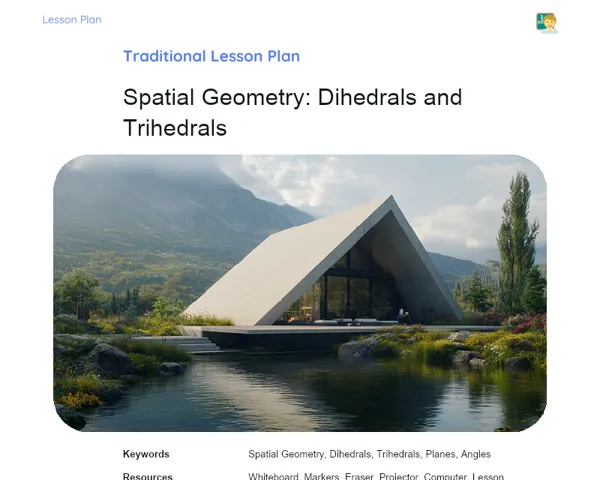Lesson Plan | Lesson Plan Tradisional | Spatial Geometry: Surface Area of the Sphere
| Keywords | Spatial Geometry, Surface Area of a Sphere, Spherical Cap, Bowl, Formula A = 4πr², Practical Examples, Problem Solving, Practical Applications, Soccer Balls, Astronomy, Engineering, High School Maths |
| Resources | Whiteboard and markers, Three-dimensional models of spheres, Calculator, Ruler or measuring tape, Worksheets with practical problems, Projector and explanatory slides (optional), Notebook and pen for learner notes |
Objectives
Duration: (10-15 minutes)
This stage aims to clearly outline the main objectives of the lesson so that learners know exactly what to expect and what is expected of them by the end. This establishes a clear focus and points learners towards the most important aspects of the content being taught.
Objectives Utama:
1. Understand and apply the formula for the surface area of a sphere.
2. Calculate the area of a spherical cap and a bowl.
3. Solve practical problems involving the surface area of spherical objects, such as a soccer ball.
Introduction
Duration: (10 - 15 minutes)
This stage sets the scene for the lesson's topic, connecting theoretical content with practical and engaging applications. This helps ignite learners' curiosity and motivates them to learn, while establishing a solid groundwork for understanding the concepts to be explored.
Did you know?
Did you know that the formula for the surface area of a sphere is used in astronomy to figure out the area of planets and stars? Also, in sports like soccer, understanding the geometry of a sphere aids in designing balls that enhance gameplay.
Contextualization
To kick off the lesson on the surface area of a sphere, explain that spatial geometry is a crucial part of maths that relates to many areas of our daily lives as well as various careers. Briefly review the characteristics of three-dimensional figures, spotlighting the sphere as a perfectly symmetrical 3D shape with no edges or vertices. Highlight the relevance of calculating the surface area of a sphere in practical scenarios, like designing spheres in engineering, making soccer balls, or even studying planets and stars.
Concepts
Duration: (50 - 60 minutes)
The aim of this section is to deepen the concepts presented in the introduction, providing learners with a thorough understanding of the surface area of a sphere, spherical caps, and bowls. Through detailed explanations, practical examples, and in-class exercises, learners will apply theory to real-life scenarios, enhancing their learning and problem-solving abilities.
Relevant Topics
1. Definition of a Sphere: Explain what a sphere is, highlighting its key characteristics, like radial symmetry and the lack of edges or vertices. Use a 3D model for better illustration.
2. Formula for the Surface Area of a Sphere: Introduce the formula A = 4πr², where A represents the surface area and r is the radius of the sphere. Explain the formula's origin and derivation.
3. Application of the Formula: Show practical examples of applying the formula to compute the surface area of spheres of various sizes, referencing everyday items like soccer balls and planets.
4. Spherical Cap: Describe the concept of a spherical cap, which is part of the sphere's surface cut by a plane. Present the formula for the area of the spherical cap and explain how to derive it from the formula for the whole sphere.
5. Calculation of the Area of a Spherical Cap: Offer practical examples of calculating the area of a spherical cap, using problems with real objects like domes and hollow spherical containers.
6. Comparison with Other Solids: Compare the surface area of a sphere with the areas of other geometric shapes, such as cylinders and cones, to reinforce comprehension of the formula and its practical uses.
To Reinforce Learning
1. Calculate the surface area of a sphere with a radius of 7 cm.
2. A hemisphere is cut in half, forming a spherical cap. If the radius of the original sphere is 10 cm, what is the surface area of the spherical cap formed?
3. A soccer ball has a radius of 11 cm. What is the total surface area of the ball?
Feedback
Duration: (20 - 25 minutes)
The goal of this stage is to review and consolidate learner understanding by discussing the answers to the earlier posed questions and addressing any uncertainties. This offers a moment for critical questioning and engagement, allowing learners to relate theory to practice and appreciate the relevance of the concepts learned in a broader context.
Diskusi Concepts
1. 🔊 Discuss Question 1: Calculate the surface area of a sphere with a radius of 7 cm.
Explanation: The formula for the surface area of a sphere is A = 4πr². Substituting the radius (r = 7 cm), we have:
A = 4π(7)² A = 4π(49) A = 196π cm²
So, the surface area is 196π cm². In approximate terms, using π ≈ 3.14, we find:
A ≈ 196 × 3.14 ≈ 615.44 cm². 2. 🔊 Discuss Question 2: A hemisphere is cut in half, forming a spherical cap. If the radius of the original sphere is 10 cm, what is the surface area of the spherical cap formed?
Explanation: The surface area of a spherical cap can be figured out using the surface area formula for the sphere while adjusting for the cap's proportion. For a spherical cap that is half a hemisphere, the area will be half the surface area of the hemisphere plus the area of the base circle.
Total surface area of the complete sphere: A = 4πr² A = 4π(10)² A = 400π cm²
Surface area of the hemisphere: A_hemisphere = 2πr² A_hemisphere = 2π(10)² A_hemisphere = 200π cm²
Area of the base circle: A_base = πr² A_base = π(10)² A_base = 100π cm²
Thus, the surface area of the spherical cap (half of a hemisphere) is:
A_cap = (1/2) × 200π + 100π A_cap = 100π + 100π A_cap = 200π cm²
In approximate terms, using π ≈ 3.14, we have:
A_cap ≈ 200 × 3.14 ≈ 628 cm². 3. 🔊 Discuss Question 3: A soccer ball has a radius of 11 cm. What is the total surface area of the ball?
Explanation: Using the surface area formula for a sphere, we have:
A = 4πr² A = 4π(11)² A = 4π(121) A = 484π cm²
Thus, the total surface area of the ball is 484π cm². In approximate terms, using π ≈ 3.14, we get:
A ≈ 484 × 3.14 ≈ 1520.56 cm².
Engaging Students
1. ❓ Ask the learners: What is the importance of understanding the surface area of a sphere in practical applications, such as the making of soccer balls? 2. ❓ Reflect with the learners: How can understanding the surface area of a sphere prove useful in other subjects, like physics and engineering? 3. ❓ Challenge the learners: If one sphere has double the radius of another, what will be the relationship between their surface areas? Why do you think that is? 4. ❓ Debate with the learners: How does the formula for the surface area of a sphere connect with other area formulas for geometric shapes you have learned, like cylinders and cones?
Conclusion
Duration: (10 - 15 minutes)
This stage aims to summarise and consolidate the key points covered in the lesson, reinforcing learner understanding. By linking theory with practice and highlighting the subject's relevance to daily life, the conclusion helps learners appreciate the value of what they have learned and how they can apply this knowledge in various contexts.
Summary
['Definition and characteristics of a sphere.', 'Formula for the surface area of a sphere: A = 4πr².', 'Practical application of the formula to calculate the area of spheres of different sizes.', 'Concept and formula of a spherical cap.', 'Calculation of the area of a spherical cap with practical examples.', 'Comparison of the surface area of a sphere with other geometric shapes.']
Connection
During the lesson, we demonstrated how the theory of the surface area of a sphere and a spherical cap is applicable to everyday situations, like in the design of soccer balls and the study of planets. Practical examples and problem-solving helped to connect theoretical concepts with their real-world applications, making the learning experience more tangible and relevant for learners.
Theme Relevance
Grasping the surface area of a sphere is vital across various fields, from astronomy to sports. Knowing how to compute this area can lead to the development of better and more efficient products, such as soccer balls that enhance performance. This understanding is also crucial in professions like engineering and physics, where accuracy in calculations pertaining to area and volume is essential.



